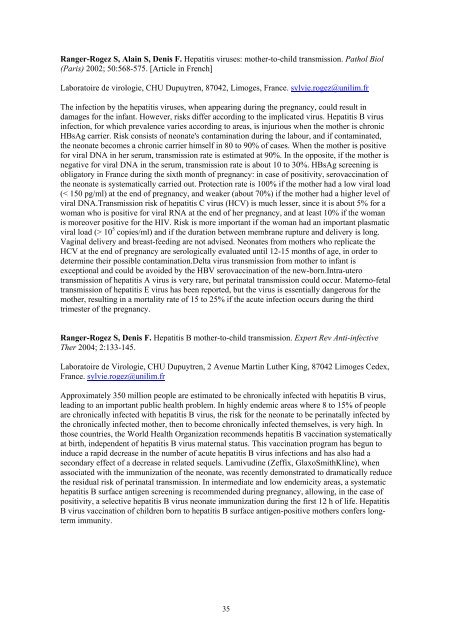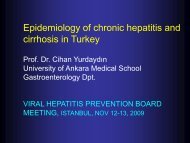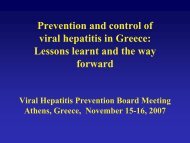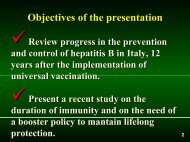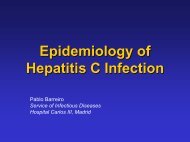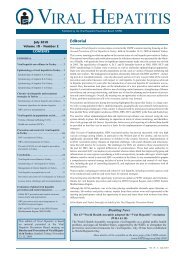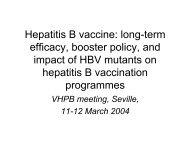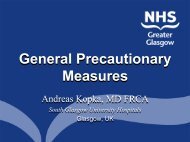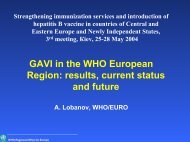Prevention and control of perinatal hepatitis B virus transmission in ...
Prevention and control of perinatal hepatitis B virus transmission in ...
Prevention and control of perinatal hepatitis B virus transmission in ...
You also want an ePaper? Increase the reach of your titles
YUMPU automatically turns print PDFs into web optimized ePapers that Google loves.
Ranger-Rogez S, Ala<strong>in</strong> S, Denis F. Hepatitis <strong>virus</strong>es: mother-to-child <strong>transmission</strong>. Pathol Biol(Paris) 2002; 50:568-575. [Article <strong>in</strong> French]Laboratoire de virologie, CHU Dupuytren, 87042, Limoges, France. sylvie.rogez@unilim.frThe <strong>in</strong>fection by the <strong>hepatitis</strong> <strong>virus</strong>es, when appear<strong>in</strong>g dur<strong>in</strong>g the pregnancy, could result <strong>in</strong>damages for the <strong>in</strong>fant. However, risks differ accord<strong>in</strong>g to the implicated <strong>virus</strong>. Hepatitis B <strong>virus</strong><strong>in</strong>fection, for which prevalence varies accord<strong>in</strong>g to areas, is <strong>in</strong>jurious when the mother is chronicHBsAg carrier. Risk consists <strong>of</strong> neonate's contam<strong>in</strong>ation dur<strong>in</strong>g the labour, <strong>and</strong> if contam<strong>in</strong>ated,the neonate becomes a chronic carrier himself <strong>in</strong> 80 to 90% <strong>of</strong> cases. When the mother is positivefor viral DNA <strong>in</strong> her serum, <strong>transmission</strong> rate is estimated at 90%. In the opposite, if the mother isnegative for viral DNA <strong>in</strong> the serum, <strong>transmission</strong> rate is about 10 to 30%. HBsAg screen<strong>in</strong>g isobligatory <strong>in</strong> France dur<strong>in</strong>g the sixth month <strong>of</strong> pregnancy: <strong>in</strong> case <strong>of</strong> positivity, serovacc<strong>in</strong>ation <strong>of</strong>the neonate is systematically carried out. Protection rate is 100% if the mother had a low viral load(< 150 pg/ml) at the end <strong>of</strong> pregnancy, <strong>and</strong> weaker (about 70%) if the mother had a higher level <strong>of</strong>viral DNA.Transmission risk <strong>of</strong> <strong>hepatitis</strong> C <strong>virus</strong> (HCV) is much lesser, s<strong>in</strong>ce it is about 5% for awoman who is positive for viral RNA at the end <strong>of</strong> her pregnancy, <strong>and</strong> at least 10% if the womanis moreover positive for the HIV. Risk is more important if the woman had an important plasmaticviral load (> 10 5 copies/ml) <strong>and</strong> if the duration between membrane rupture <strong>and</strong> delivery is long.Vag<strong>in</strong>al delivery <strong>and</strong> breast-feed<strong>in</strong>g are not advised. Neonates from mothers who replicate theHCV at the end <strong>of</strong> pregnancy are serologically evaluated until 12-15 months <strong>of</strong> age, <strong>in</strong> order todeterm<strong>in</strong>e their possible contam<strong>in</strong>ation.Delta <strong>virus</strong> <strong>transmission</strong> from mother to <strong>in</strong>fant isexceptional <strong>and</strong> could be avoided by the HBV serovacc<strong>in</strong>ation <strong>of</strong> the new-born.Intra-utero<strong>transmission</strong> <strong>of</strong> <strong>hepatitis</strong> A <strong>virus</strong> is very rare, but <strong>per<strong>in</strong>atal</strong> <strong>transmission</strong> could occur. Materno-fetal<strong>transmission</strong> <strong>of</strong> <strong>hepatitis</strong> E <strong>virus</strong> has been reported, but the <strong>virus</strong> is essentially dangerous for themother, result<strong>in</strong>g <strong>in</strong> a mortality rate <strong>of</strong> 15 to 25% if the acute <strong>in</strong>fection occurs dur<strong>in</strong>g the thirdtrimester <strong>of</strong> the pregnancy.Ranger-Rogez S, Denis F. Hepatitis B mother-to-child <strong>transmission</strong>. Expert Rev Anti-<strong>in</strong>fectiveTher 2004; 2:133-145.Laboratoire de Virologie, CHU Dupuytren, 2 Avenue Mart<strong>in</strong> Luther K<strong>in</strong>g, 87042 Limoges Cedex,France. sylvie.rogez@unilim.frApproximately 350 million people are estimated to be chronically <strong>in</strong>fected with <strong>hepatitis</strong> B <strong>virus</strong>,lead<strong>in</strong>g to an important public health problem. In highly endemic areas where 8 to 15% <strong>of</strong> peopleare chronically <strong>in</strong>fected with <strong>hepatitis</strong> B <strong>virus</strong>, the risk for the neonate to be <strong>per<strong>in</strong>atal</strong>ly <strong>in</strong>fected bythe chronically <strong>in</strong>fected mother, then to become chronically <strong>in</strong>fected themselves, is very high. Inthose countries, the World Health Organization recommends <strong>hepatitis</strong> B vacc<strong>in</strong>ation systematicallyat birth, <strong>in</strong>dependent <strong>of</strong> <strong>hepatitis</strong> B <strong>virus</strong> maternal status. This vacc<strong>in</strong>ation program has begun to<strong>in</strong>duce a rapid decrease <strong>in</strong> the number <strong>of</strong> acute <strong>hepatitis</strong> B <strong>virus</strong> <strong>in</strong>fections <strong>and</strong> has also had asecondary effect <strong>of</strong> a decrease <strong>in</strong> related sequels. Lamivud<strong>in</strong>e (Zeffix, GlaxoSmithKl<strong>in</strong>e), whenassociated with the immunization <strong>of</strong> the neonate, was recently demonstrated to dramatically reducethe residual risk <strong>of</strong> <strong>per<strong>in</strong>atal</strong> <strong>transmission</strong>. In <strong>in</strong>termediate <strong>and</strong> low endemicity areas, a systematic<strong>hepatitis</strong> B surface antigen screen<strong>in</strong>g is recommended dur<strong>in</strong>g pregnancy, allow<strong>in</strong>g, <strong>in</strong> the case <strong>of</strong>positivity, a selective <strong>hepatitis</strong> B <strong>virus</strong> neonate immunization dur<strong>in</strong>g the first 12 h <strong>of</strong> life. HepatitisB <strong>virus</strong> vacc<strong>in</strong>ation <strong>of</strong> children born to <strong>hepatitis</strong> B surface antigen-positive mothers confers longtermimmunity.35


